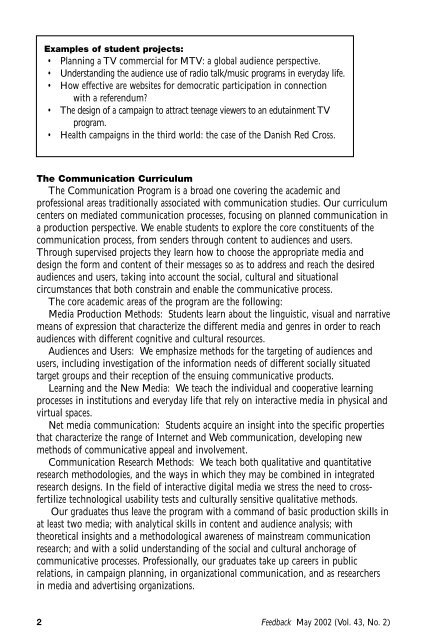Feedback May 2002 (Vol 43 No 2)
Feedback May 2002 (Vol. 43, No. 2) - Broadcast Education ...
Feedback May 2002 (Vol. 43, No. 2) - Broadcast Education ...
- No tags were found...
Create successful ePaper yourself
Turn your PDF publications into a flip-book with our unique Google optimized e-Paper software.
Examples of student projects:• Planning a TV commercial for MTV: a global audience perspective.• Understanding the audience use of radio talk/music programs in everyday life.• How effective are websites for democratic participation in connectionwith a referendum?• The design of a campaign to attract teenage viewers to an edutainment TVprogram.• Health campaigns in the third world: the case of the Danish Red Cross.The Communication CurriculumThe Communication Program is a broad one covering the academic andprofessional areas traditionally associated with communication studies. Our curriculumcenters on mediated communication processes, focusing on planned communication ina production perspective. We enable students to explore the core constituents of thecommunication process, from senders through content to audiences and users.Through supervised projects they learn how to choose the appropriate media anddesign the form and content of their messages so as to address and reach the desiredaudiences and users, taking into account the social, cultural and situationalcircumstances that both constrain and enable the communicative process.The core academic areas of the program are the following:Media Production Methods: Students learn about the linguistic, visual and narrativemeans of expression that characterize the different media and genres in order to reachaudiences with different cognitive and cultural resources.Audiences and Users: We emphasize methods for the targeting of audiences andusers, including investigation of the information needs of different socially situatedtarget groups and their reception of the ensuing communicative products.Learning and the New Media: We teach the individual and cooperative learningprocesses in institutions and everyday life that rely on interactive media in physical andvirtual spaces.Net media communication: Students acquire an insight into the specific propertiesthat characterize the range of Internet and Web communication, developing newmethods of communicative appeal and involvement.Communication Research Methods: We teach both qualitative and quantitativeresearch methodologies, and the ways in which they may be combined in integratedresearch designs. In the field of interactive digital media we stress the need to crossfertilizetechnological usability tests and culturally sensitive qualitative methods.Our graduates thus leave the program with a command of basic production skills inat least two media; with analytical skills in content and audience analysis; withtheoretical insights and a methodological awareness of mainstream communicationresearch; and with a solid understanding of the social and cultural anchorage ofcommunicative processes. Professionally, our graduates take up careers in publicrelations, in campaign planning, in organizational communication, and as researchersin media and advertising organizations.2<strong>Feedback</strong> <strong>May</strong> <strong>2002</strong> (<strong>Vol</strong>. <strong>43</strong>, <strong>No</strong>. 2)
















